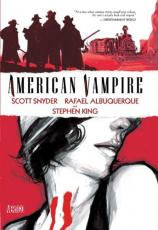American Vampire, Vol. 1
Review
American Vampire, Vol. 1
Collecting the first fives issues of Scott Snyder and Stephen King’s new creator-owned series, the trade hardcover American Vampire, Vol. 1 introduces Pearl Jones, a would-be actress in 1920s Los Angeles. Lured to a Hollywood producer's lavish party, she is fed to a gang of vampires and left for dead in the desert. After being found and hospitalized, she is saved—or perhaps condemned—by Skinner Sweet, the first American vampire.
The origin of Sweet, written by Stephen King, is presented in backup stories to each of the five chapters. As a murderous outlaw of the American west in the late 1800s, Sweet was attacked and accidentally turned by an old-world vampire. “Sometimes, when the blood hits someone new, from somewhere new…it makes something new,” Sweet explains. He is an evolutionary step forward in the vampire lineage: stronger, faster, and more ferocious than his ancient European counterparts—and immune to the sun.
The cultural dichotomy presented between the old European and the new American vampires are particularly interesting. The European vampires are clustered in groups, hidden in the dark, seeking wealth by manipulating events in the outside world from behind the scenes. When they feed, there's an aristocratic ego behind it, as if their victims were merely cattle. The Americans, meanwhile, are loners in search of fame and revenge, feeding on others out of hatred or necessity, taking for themselves what they believe should be theirs.
The historical time periods the authors have chosen help to inform the creation of these American vampires wonderfully. In American mythology and the birth of celebrity, nothing is more recognizable than the images of the Wild West. Notorious outlaws gained fame through their violent exploits, and heroes were made of the lawmen who stopped them. It makes a great deal of sense then that the first American vampire, a Billy the Kid-like antihero, would be born of that era.
With the birth of cinema and talkies, Hollywood created a new mythology and new heroes, on and off the silver screen. Men and women followed their dreams to Tinseltown, hoping to become the next star for the world to swoon over, capturing fortune and fame. It's what drew Pearl away from her family farm, to become a movie-set extra, one of three jobs she works to make rent while hoping her ambition pays off. While she may not find immortality as a Hollywood starlet, she may find it as the next American vampire.
While Pearl and Sweet are diametric opposites, both are equally defined in their pursuit of fame and, later, revenge. Even though their stories are penned by different writers, the book has a cohesive feel to it. Snyder and King make for strong collaborators with an equally strong grasp on the stories that need to be told. King in particular makes terrific use of the Old West for his segments, comingling bloody vampire mythos with bank robberies, shootouts, and train raids. There's an infectious amount of fun and horror in learning what Sweet is capable of, even as he learns himself. Less tangible is the 1920s setting Snyder uses. There's plenty of references made to the technologies of the time, but it doesn't feel as grounded in its setting as it should. Perhaps because of its Hollywood setting it feels too familiar and modernistic, as if it could be interchanged with nearly any other decade for equal results. However, the time chosen is as salient a period in U.S. history as the Wild West, not only for the purpose of the story, but also in helping to solidify the thematic concepts behind what is, exactly, an American vampire.
In this opening volume, Snyder shows an interesting and fresh take on the vampire mythos, exploring it through the lens of a particular culture with its own psyche. In setting up the concept of rival bloodlines between the traditional European and contemporary American vampires, and a promise to follow the American vampires through decades of U.S. history, Snyder opens the door for what will, hopefully, prove to be an ambitious, gory, entertaining, and, ultimately, important piece of work.
Reviewed by Michael Hicks on July 3, 2012
American Vampire, Vol. 1
- Publication Date: October 5, 2010
- Genres: Graphic Novel
- Hardcover: 200 pages
- Publisher: Vertigo
- ISBN-10: 1401228305
- ISBN-13: 9781401228309






